Due to the ability to turn inexpensive minerals into highly valuable objects, early porcelain was seen as white gold. Today the value of these ceramics, especially early and rare examples, can reach phenomenal prices at auction. Meissen is the leading name in this area of the art market, with rococo figurines and decorative objects reflective of its beginnings in the 18th century.
 Above: a Meissen figurine pair before and after professional restoration in our studio
Above: a Meissen figurine pair before and after professional restoration in our studio
As the very first producer of hard-paste porcelain in Europe, Meissen lead the way with royal connections. The discovery of a hard-paste porcelain recipe outside of Asia was a much sought-after solution for the demands of new European designs. Under the instruction and finance of Augustus the Strong, King of Poland and Elector of Saxon, and a secret production process, Meissen produced a new form of European art, no longer relying on the replication or import of Chinese and Japanese ceramics.
 Above: a selection of Meissen porcelain, including a saucer (1724-25), a snuff-box (1750), figurines of Columbine and Pantaloon (1741), a jug (1760) and one of a pair of quetzal birds (1733)
Above: a selection of Meissen porcelain, including a saucer (1724-25), a snuff-box (1750), figurines of Columbine and Pantaloon (1741), a jug (1760) and one of a pair of quetzal birds (1733)
This article will discover the history of Meissen porcelain, including details on how to identify maker’s marks, signs of age, and the ways in which these valuable items can be safely cared for at home. Ceramic restoration of the highest standard is also possible for Meissen designs, so we will also explain the processes behind professional treatments and sensitive conservation work.
 Above: Meissen figurines of Chinese musicians (1763-64) and a tray set with cups in a Chinoiserie design (1740)
Above: Meissen figurines of Chinese musicians (1763-64) and a tray set with cups in a Chinoiserie design (1740)
History and styles of Meissen porcelain
Augustus the Strong, like many other European leaders of the era, had an obsession with art and decorative objects. His interest in the Meissen project was so intense that he described himself as having porcelain fever, putting alchemist Johann Friedrich Böttger under protective custody to ensure his court would be the first to discover the process. Böttger worked alongside scientist Ehrenfried Walther von Tschirnhaus, finally succeeding in 1707 by including kaolin and ensuring it was fired at high temperatures of around 1400 degrees.
 Above: a selection of Meissen ceramics from the early 18th century with a Meissen stoneware sculpture of Augustus The Strong (centre)
Above: a selection of Meissen ceramics from the early 18th century with a Meissen stoneware sculpture of Augustus The Strong (centre)
Meissen porcelain began production in 1710 in the newly established Royal-Polish and Electoral-Saxon Porcelain Manufactory and became commercially available in 1713, though it was only afforded by royalty and those in the upper spheres of the aristocracy. To ensure the arcanum of hard-paste porcelain was safe, Böttger’s laboratory was placed within Albrechtsburg castle, where it remained for the next 150 years.
 Above: a selection of Meissen porcelain with Chinoiserie designs, including a saucer and tea cup, a vase and a peach-shaped teapot
Above: a selection of Meissen porcelain with Chinoiserie designs, including a saucer and tea cup, a vase and a peach-shaped teapot
Early designs used Chinoiserie patterns and Asian inspiration, reflecting on the variety of ceramics that the gentry were used to collecting as a sign of wealth and status. Johann Gregor Herold began producing designs in the 1720s that allowed for the use of under-glaze and over-glaze colours and gilding, using enamel paints to create precise landscapes, animals, floral and court scenes. Some of these decorative features copied the works of artists such as Watteau. Other typical styles from this early period feature laub- und bandelwerk – a lace-like pattern around the edges, often gilded, as well as patterns such as Indian Flowers and Kakiemon.
 Above: a lion and lioness by Meissen as they were designed for the Japanese Palace, 1732
Above: a lion and lioness by Meissen as they were designed for the Japanese Palace, 1732
Sculptural work appears from the 1730s onwards, a variety of lifesize animals were expertly created for the Japanese Palace in Dresden, creating a porcelain menagerie of exotic and domestic species. In the mid-18th century, strong influences of baroque and rococo grandeur took hold, seeing the production of figures and large decorative displays to be used in table settings or as centrepieces for extravagant balls. Figures from this period reflect the mythology, allegory and pastoral imagery used in oil paintings by the likes of Boucher and Fragonard. Famous centrepieces include ‘snowball blossoms’ and the ‘swan service’.
 Above: a pair of Swan candelabrum with Meissen porcelain and a gilt-bronze mount, 1745-50
Above: a pair of Swan candelabrum with Meissen porcelain and a gilt-bronze mount, 1745-50
From 1774 to 1813, the Meissen factory was under the instruction of Count Camillo Marcolini. This neoclassical era used inspiration from new discoveries at Pompeii and classical architecture, as well as monochrome details and at some stages even matt, unglazed wares, were produced. In the 19th century, the factory also re-produced many of its rococo figurines, in some cases they were modernised for current taste. For a long time Meissen relied on the constant reproduction of past decorations, or the copy of art historical pieces, it was not until the early 20th century that innovative creativity returned with Art Nouveau styles.
 Above: a selection of Meissen porcelain, including parrots, a snuff-box, a centrepiece on a gilded mount, animal boxes and a clock case
Above: a selection of Meissen porcelain, including parrots, a snuff-box, a centrepiece on a gilded mount, animal boxes and a clock case
Meissen maker’s marks & identification
Once the secrets of white gold spread across Europe, Meissen needed to establish itself as an authentic product. In 1722 it began using maker’s marks, featuring the initials of the king or factory.

Typical initials you will find on early Meissen include:
- K.P.M. (Königliche Porzellan-Manufaktur)
- AR (Augustus Rex)
- K.P.F. (Königliche Porzellan-Fabrik)
- M.P.M. (Meissener Porzellan-Manufaktur)
 Above: examples of Meissen maker’s marks, these may have become obscured or blurred under the glaze
Above: examples of Meissen maker’s marks, these may have become obscured or blurred under the glaze
These were later consolidated into one mark, a classic crossed-swords symbol that was based on the arms of the Arch-Marshal of the Holy Roman Empire. Early versions of the crossing swords will appear less stylised or official as it was not originally seen as an important marking, from the 1760s onwards the markings become more uniform in their appearance.
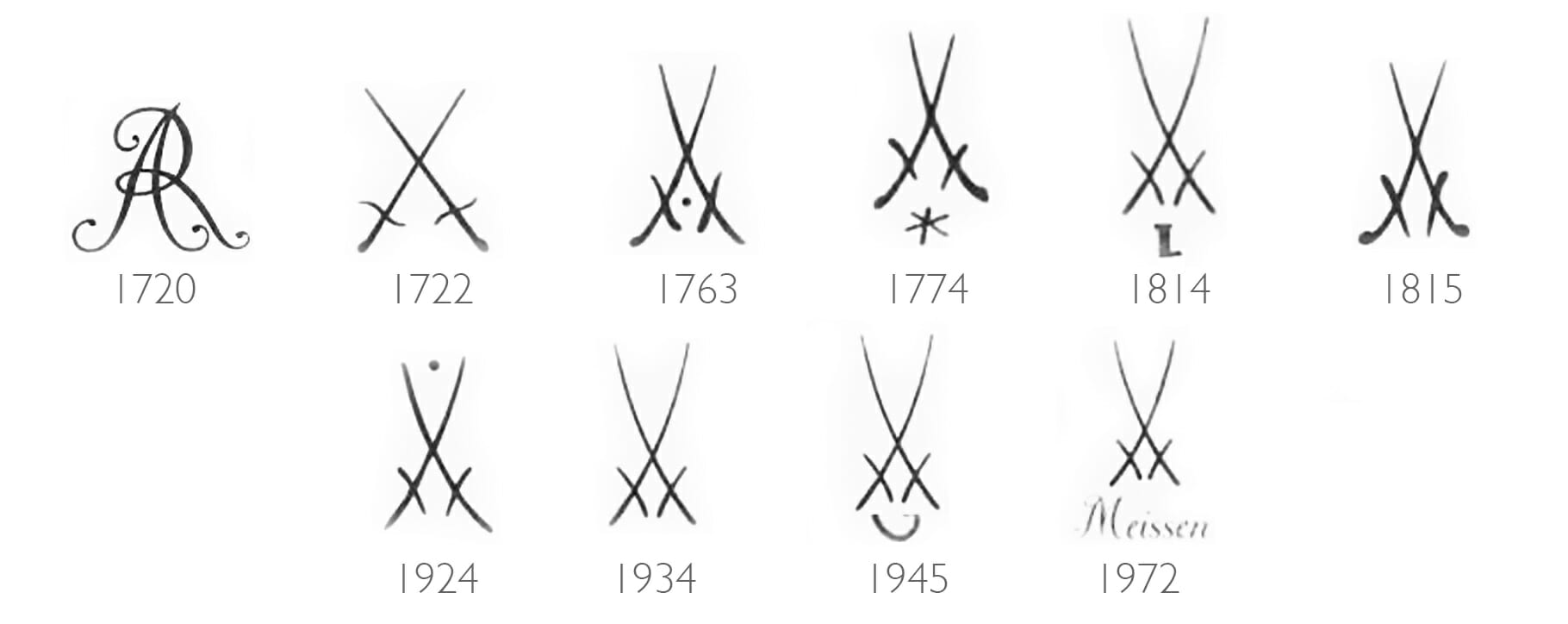
Meissen care & display
Antique and valuable porcelain should always be kept behind glass, this will avoid any disturbances from dust or atmospheric particles and help to prevent accidental knocks and falls. Whether or not an item is in a protective casing, it should always have a felt, leather or soft fabric mat placed beneath it to absorb any shaking from footsteps or vibrations. If you require display fittings for items such as plates or tableware, always opt for a non-metallic material such as plastic, as this will avoid any scratches or transference of tarnish.
 Above: a selection of Meissen figures on display
Above: a selection of Meissen figures on display
Avoid direct sunlight or humid conditions, we recommend an atmosphere with a steady temperature of around 20 degrees and a relative humidity of around 50%. UV rays from sunlight will cause temperature fluctuations and in some cases, especially when the painted details are over-glaze, chemical reactions or fading may occur. If you have very sensitive pieces, consider placing UV protective filters on windows or glass casings. If you would like to use an antique vase for display with fresh flowers, consider using a separate container for water within the body of the object, to ensure nothing touches the delicate surface.
 Above: a conservator holding a ceramic item in our studio
Above: a conservator holding a ceramic item in our studio
Porcelain should be handled as little as possible, but when required this should be performed with clean hands and by carefully holding the item by a strong part of the body – not by handles or potentially weak extremities. Do not use anything to stick lids or extra pieces together, instead ensure everything is wrapped separately for storage or transport.
 Above: our conservator gently cleaning the surface of a ceramic figurine with a small swab
Above: our conservator gently cleaning the surface of a ceramic figurine with a small swab
Cleaning should only be undertaken when entirely necessary, if an item is stained or heavily soiled by dirt or debris, it may be a task for a conservator to prevent any damage from occurring. Light dusting can be performed with a lint-free cloth, but any abrasive sponges or harsh chemicals should be avoided. If a porcelain piece has over-glaze painting or gilding, take care not to rub these areas, as they have no protective layer.
 Above: Meissen ornaments may feature under and over glazed painting, as well as gilded areas that can be vulnerable to abrasion
Above: Meissen ornaments may feature under and over glazed painting, as well as gilded areas that can be vulnerable to abrasion
How to deal with breakages
In the event that a Meissen porcelain figurine or object becomes broken, always take care to collect all of the pieces no matter how small. This is because a professional ceramics conservator will always strive to use all of the original pieces when it comes to restoration.
 Above: pieces of a broken Meissen figurine before restoration
Above: pieces of a broken Meissen figurine before restoration
Do not attempt to use glue or tape to repair broken areas, as the acidic properties from these will yellow and discolour the areas over time. Adhesive substances may also disturb any paintwork or detailing when removed, so the best plan of action is to wrap all pieces individually in acid-free tissue paper in preparation for professional care.
Meissen porcelain restoration
Our professional ceramics conservator is able to restore porcelain with invisible results. This includes the reconstruction of broken pieces with seamless joins and even the recreation of missing parts where required.
 Above: our ceramics conservator restoring small amounts of pigment to a Meissen parrot figurine
Above: our ceramics conservator restoring small amounts of pigment to a Meissen parrot figurine
If the item has a breakage or missing area, ceramic restoration has several stages. Firstly the item is gently surface-cleaned and weak points are assessed. Any broken edges are prepared for the re-adhesion of original parts or replica pieces. These are applied using conservation-approved solutions that will not yellow or damage the item over time, as a traditional glue would.
 Above: historic repairs such as stapled joins can also be repaired with an invisible finish
Above: historic repairs such as stapled joins can also be repaired with an invisible finish
If there are any areas of lost glazing or pigment, our conservator can carefully colour-match and recreate the original appearance. All of these aspects take place over many days as the areas are professionally prepped and allowed to dry. The result is often amazing to our clients, as the original breakage is hard to find due to the perfect finish.
 Above: a broken lid on a ginger pot with a sympathetically recreated decoration, carefully colour-matched to the original gilding
Above: a broken lid on a ginger pot with a sympathetically recreated decoration, carefully colour-matched to the original gilding
If a porcelain piece is stained or embedded with dust and grime, our conservator can use a customised solution that is the correct strength for the surface of the piece (as not to disturb any original paintwork or gilding). Using small swabs, all areas can be cleaned and the result will be a bright, original surface. This type of work is often conducted following a household disaster, such as a fire, leak or flood, where harmful contaminants may be clinging to the surface.
 Above: this vase was shattered after an accidental fall, but fully restored with a seamless result following professional care in our studio
Above: this vase was shattered after an accidental fall, but fully restored with a seamless result following professional care in our studio
Will restoration affect the value of Meissen porcelain?
Whilst a breakage of any kind may affect the value of antique artworks, restoration conducted to a professional standard will allow the piece to gain a higher value at auction when compared to results for a figurine or tableware item that has missing parts or visual disturbances.
Our ceramics conservator has seen her work reach respectable outcomes at auction following the recreation of missing and broken pieces. Likewise, we often have broken items received post-auction that have been purchased with the intention of restoration. Conservators in our studio all carry Masters degrees or an equivalent qualification and have been trained to museum-level standards.
How can we help?
If you have a piece of Meissen porcelain in need of professional care or restoration, please contact our helpful team for further advice.
Please get in touch by emailing [email protected] or call 0207 112 7576 for swift advice and a conversation about our services.

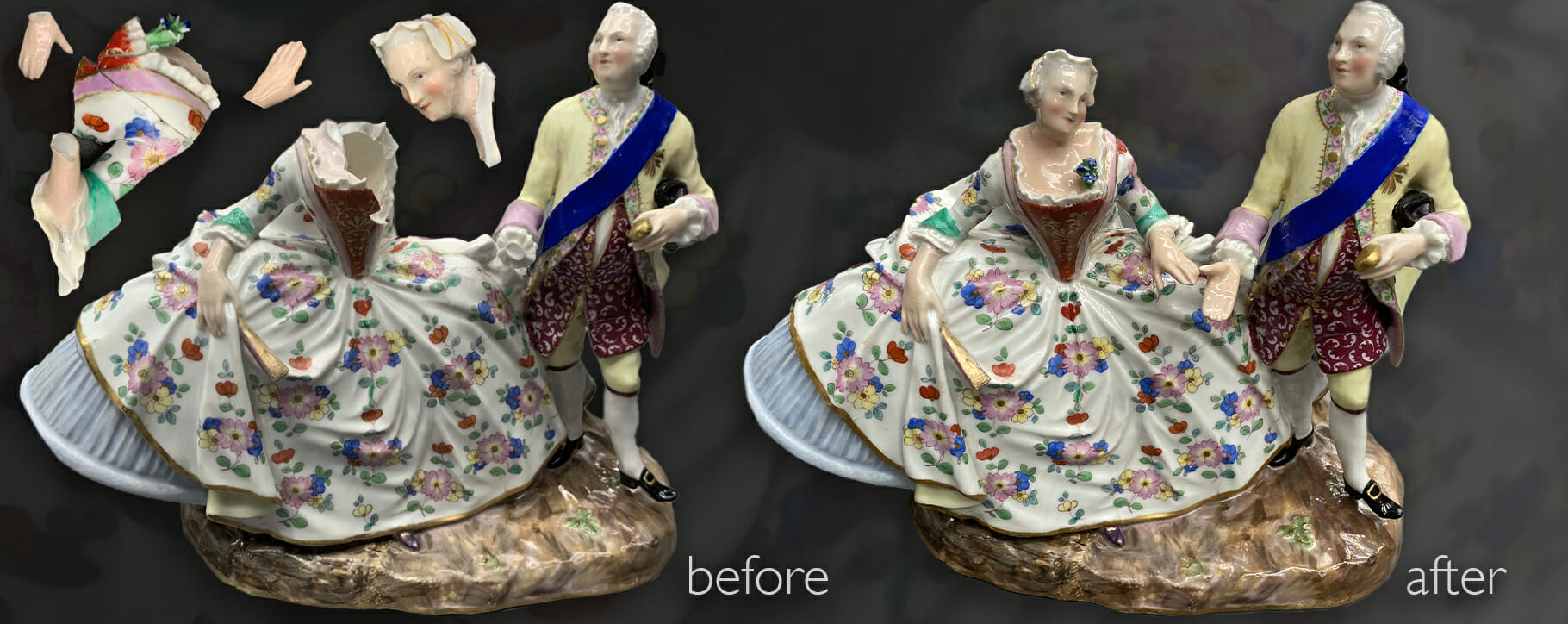 Above: a Meissen figurine pair before and after professional restoration in our studio
Above: a Meissen figurine pair before and after professional restoration in our studio Above: a selection of Meissen porcelain, including a saucer (1724-25), a snuff-box (1750), figurines of Columbine and Pantaloon (1741), a jug (1760) and one of a pair of quetzal birds (1733)
Above: a selection of Meissen porcelain, including a saucer (1724-25), a snuff-box (1750), figurines of Columbine and Pantaloon (1741), a jug (1760) and one of a pair of quetzal birds (1733)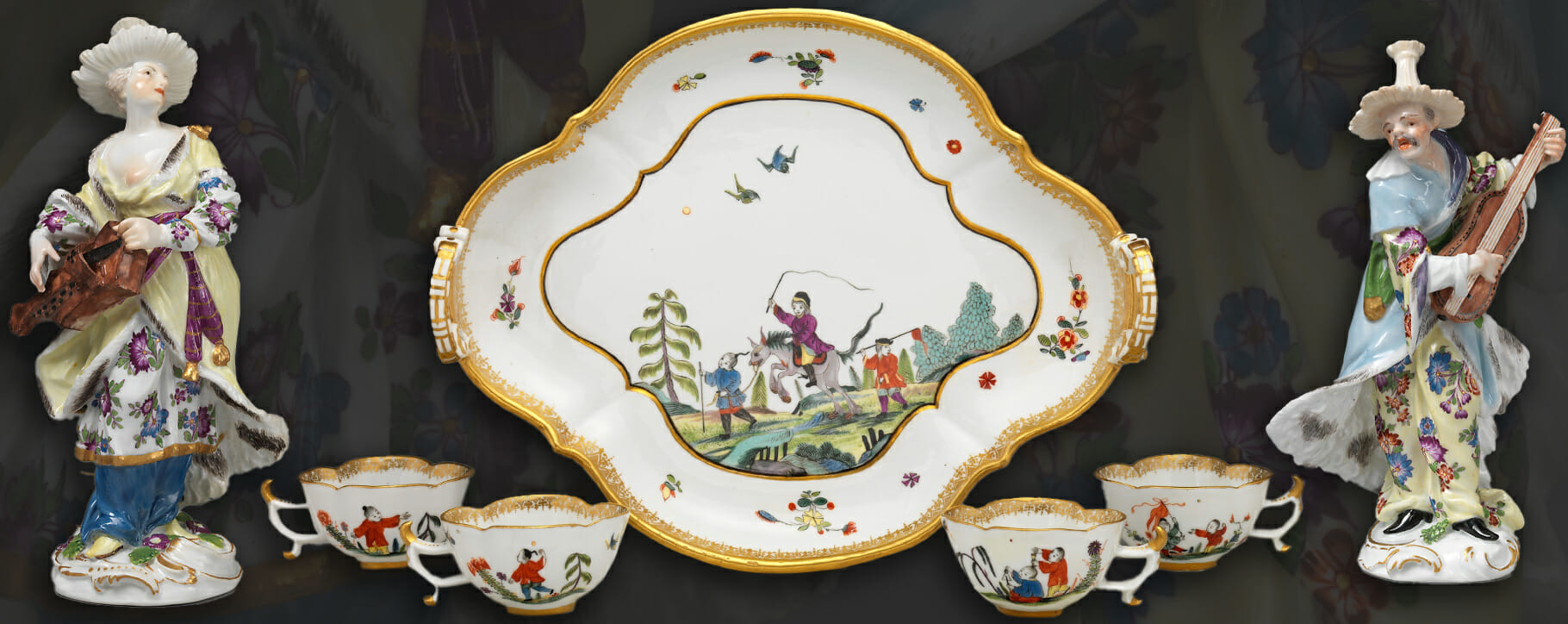 Above: Meissen figurines of Chinese musicians (1763-64) and a tray set with cups in a Chinoiserie design (1740)
Above: Meissen figurines of Chinese musicians (1763-64) and a tray set with cups in a Chinoiserie design (1740) Above: a selection of Meissen ceramics from the early 18th century with a Meissen stoneware sculpture of Augustus The Strong (centre)
Above: a selection of Meissen ceramics from the early 18th century with a Meissen stoneware sculpture of Augustus The Strong (centre)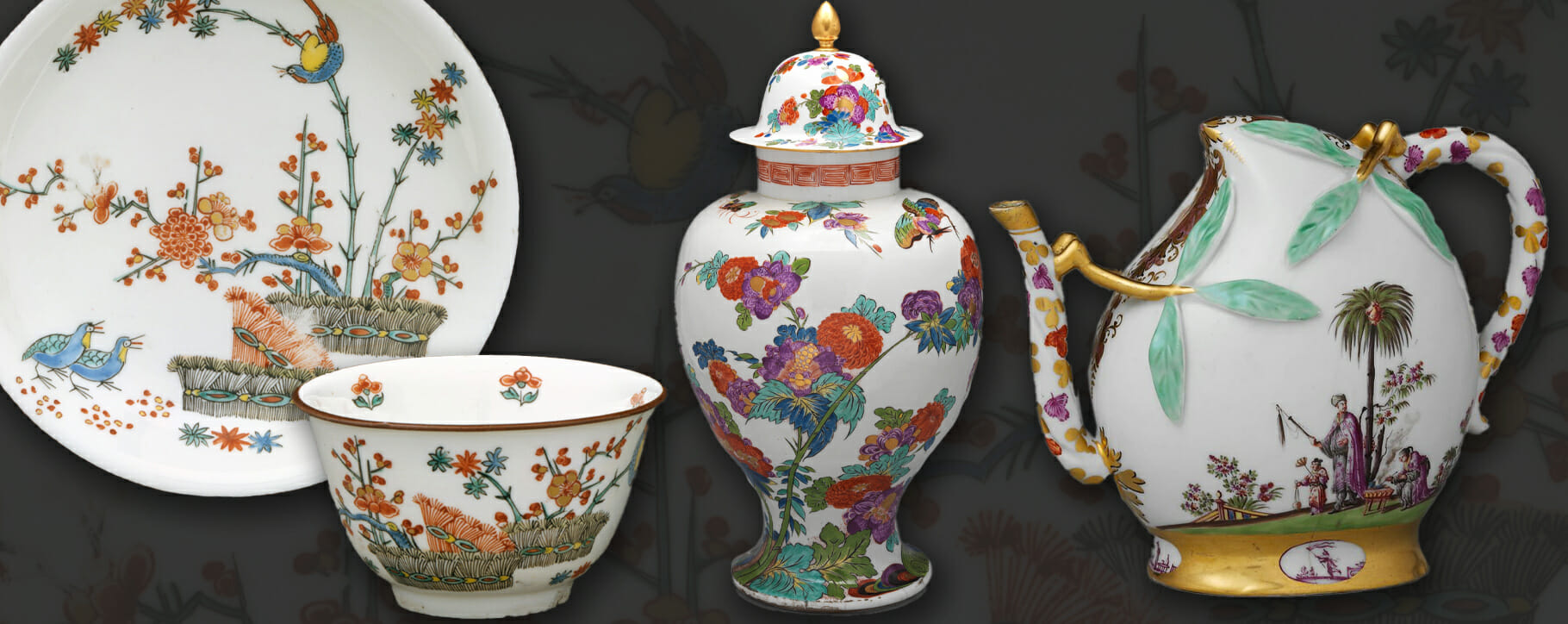 Above: a selection of Meissen porcelain with Chinoiserie designs, including a saucer and tea cup, a vase and a peach-shaped teapot
Above: a selection of Meissen porcelain with Chinoiserie designs, including a saucer and tea cup, a vase and a peach-shaped teapot 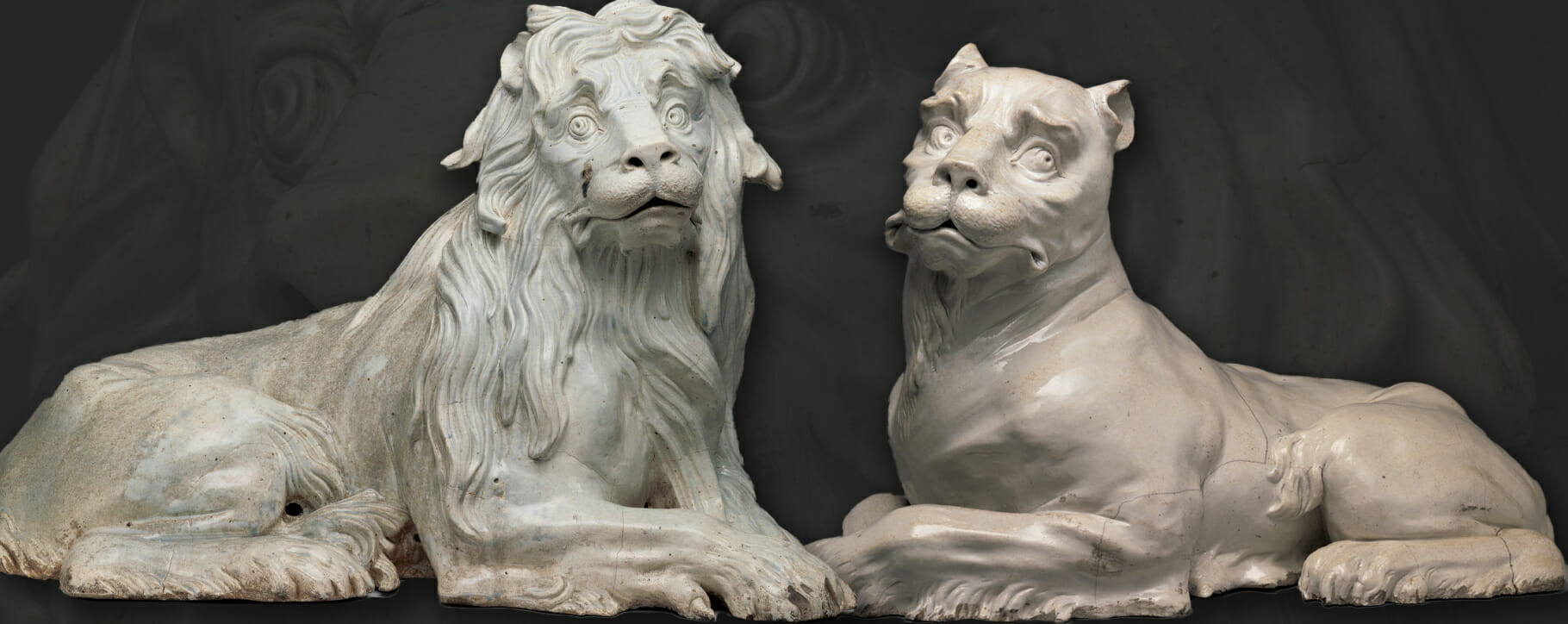 Above: a lion and lioness by Meissen as they were designed for the Japanese Palace, 1732
Above: a lion and lioness by Meissen as they were designed for the Japanese Palace, 1732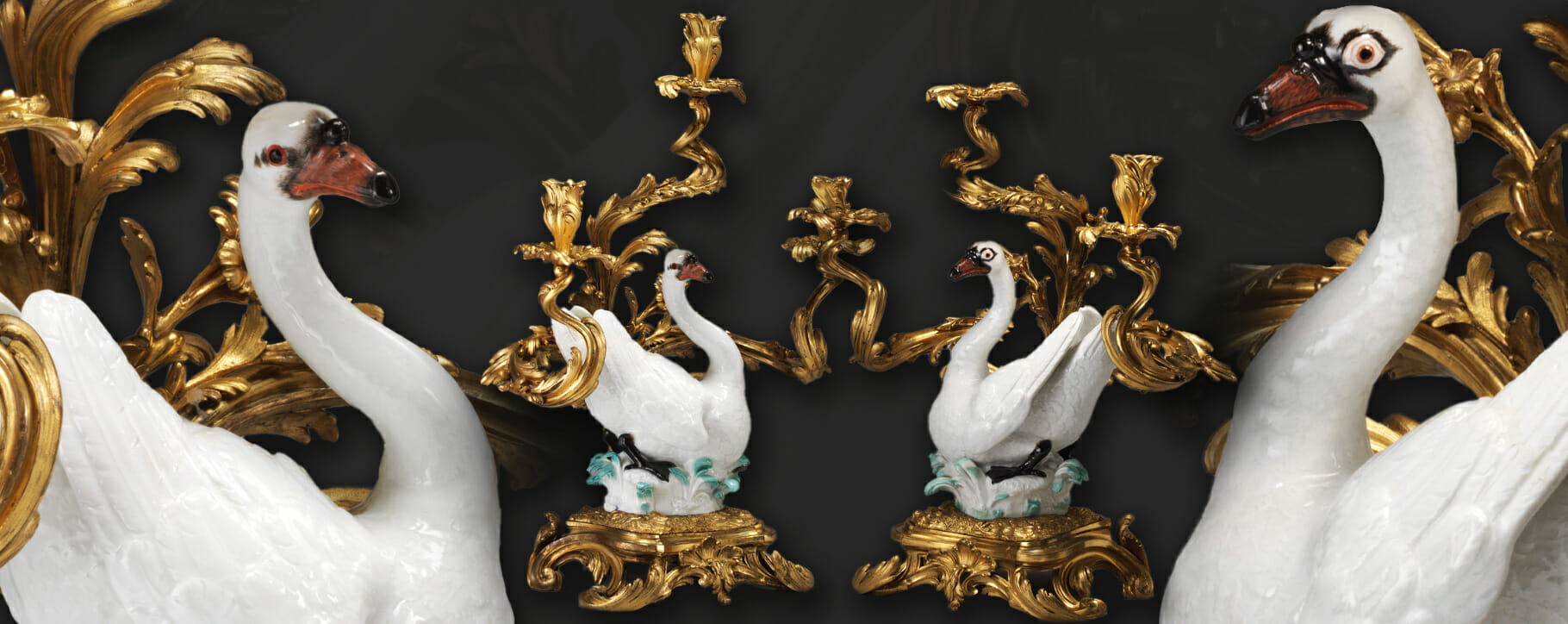 Above: a pair of Swan candelabrum with Meissen porcelain and a gilt-bronze mount, 1745-50
Above: a pair of Swan candelabrum with Meissen porcelain and a gilt-bronze mount, 1745-50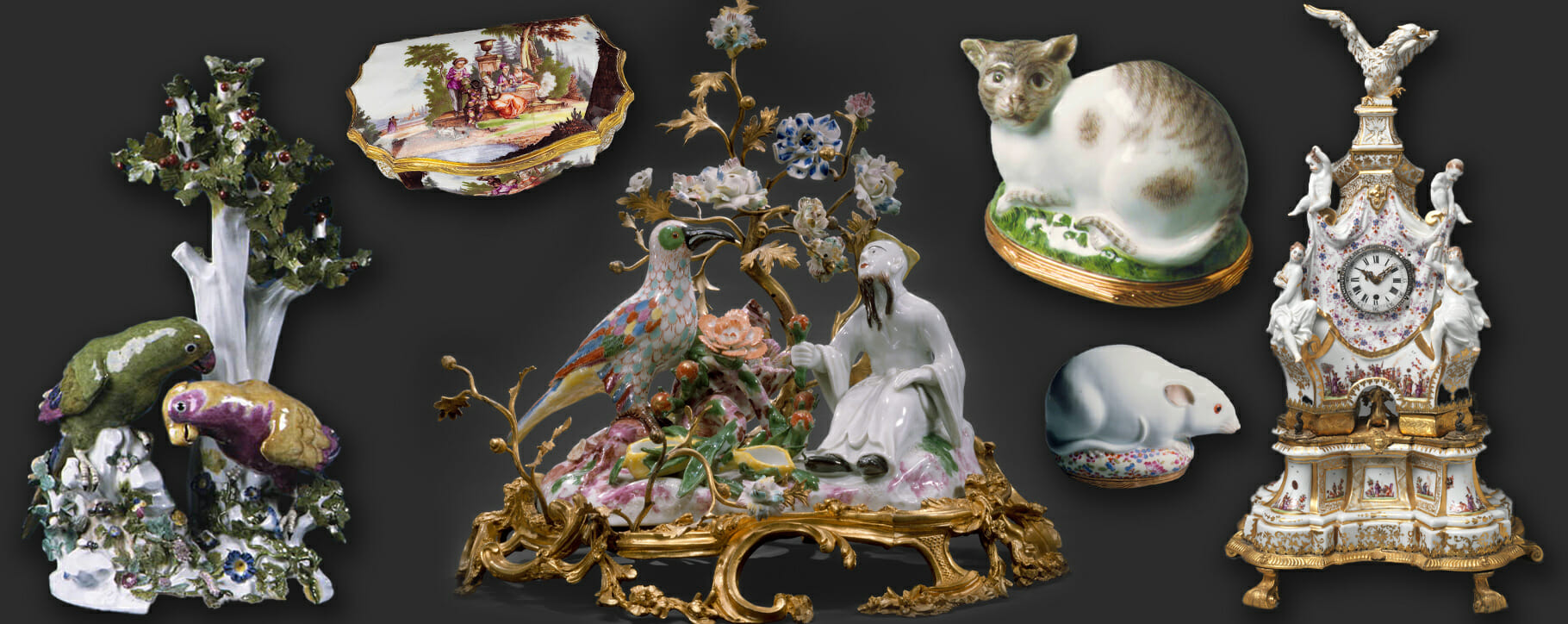 Above: a selection of Meissen porcelain, including parrots, a snuff-box, a centrepiece on a gilded mount, animal boxes and a clock case
Above: a selection of Meissen porcelain, including parrots, a snuff-box, a centrepiece on a gilded mount, animal boxes and a clock case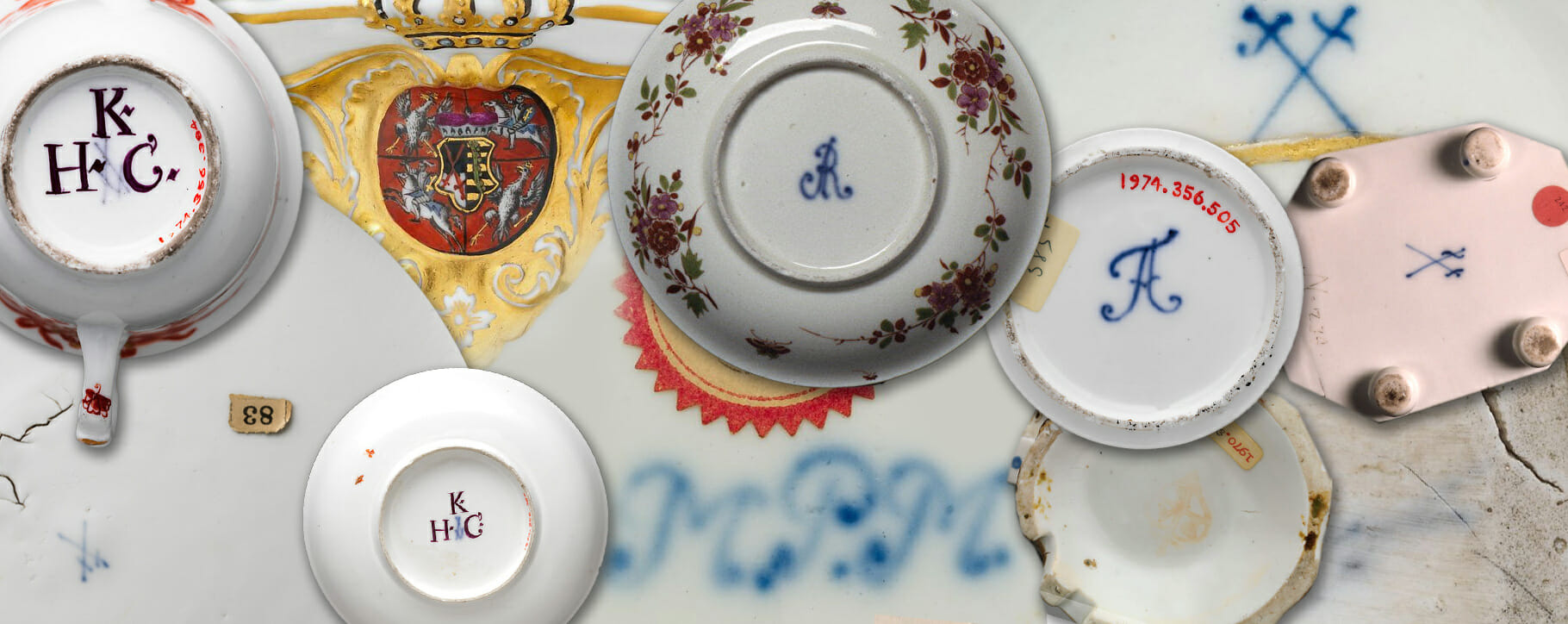 Above: examples of Meissen maker’s marks, these may have become obscured or blurred under the glaze
Above: examples of Meissen maker’s marks, these may have become obscured or blurred under the glaze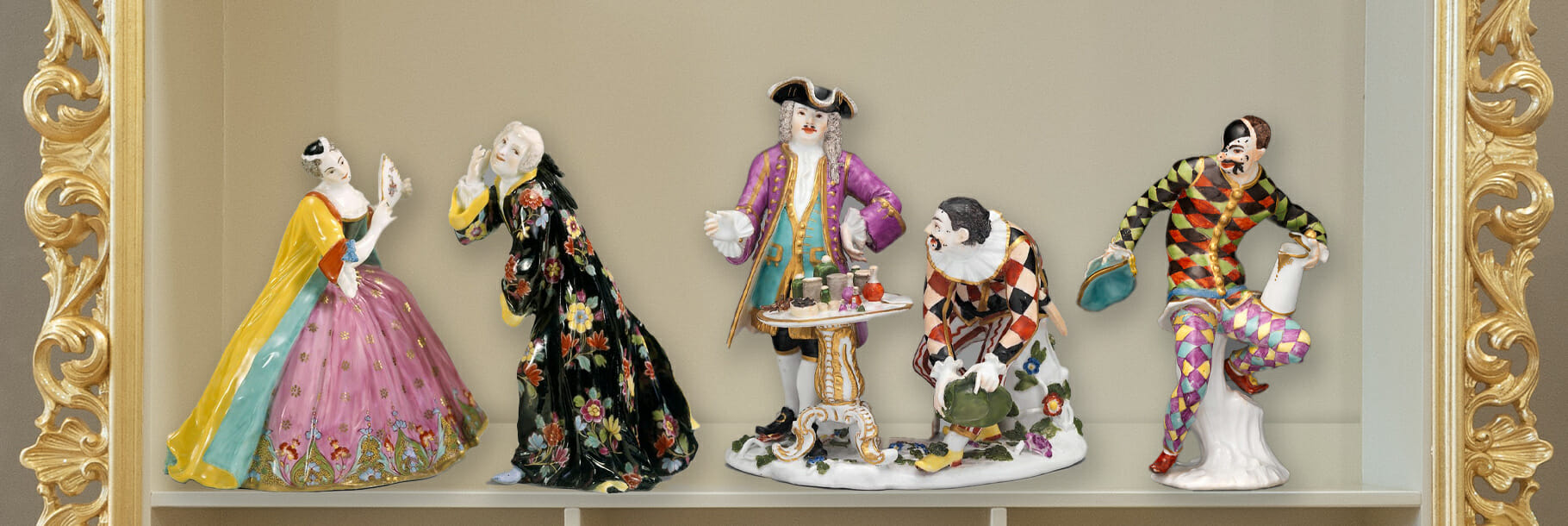 Above: a selection of Meissen figures on display
Above: a selection of Meissen figures on display Above: a conservator holding a ceramic item in our studio
Above: a conservator holding a ceramic item in our studio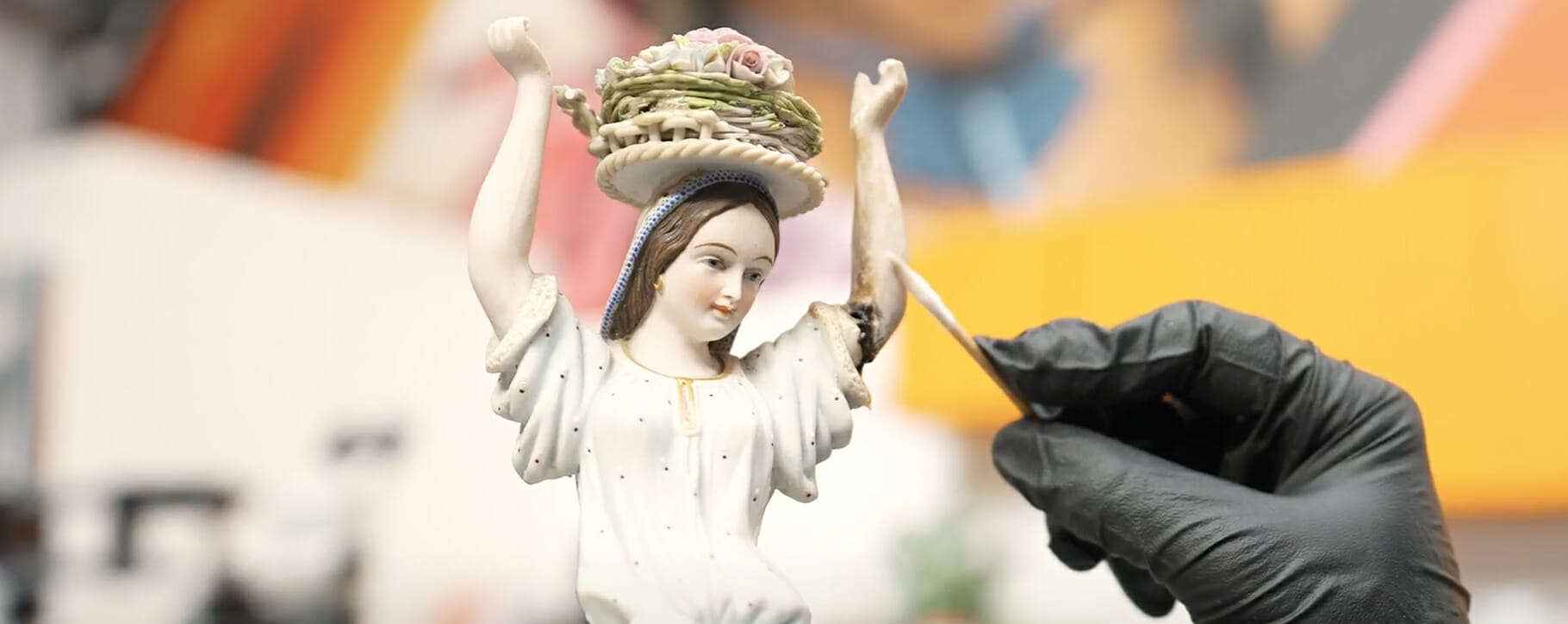 Above: our conservator gently cleaning the surface of a ceramic figurine with a small swab
Above: our conservator gently cleaning the surface of a ceramic figurine with a small swab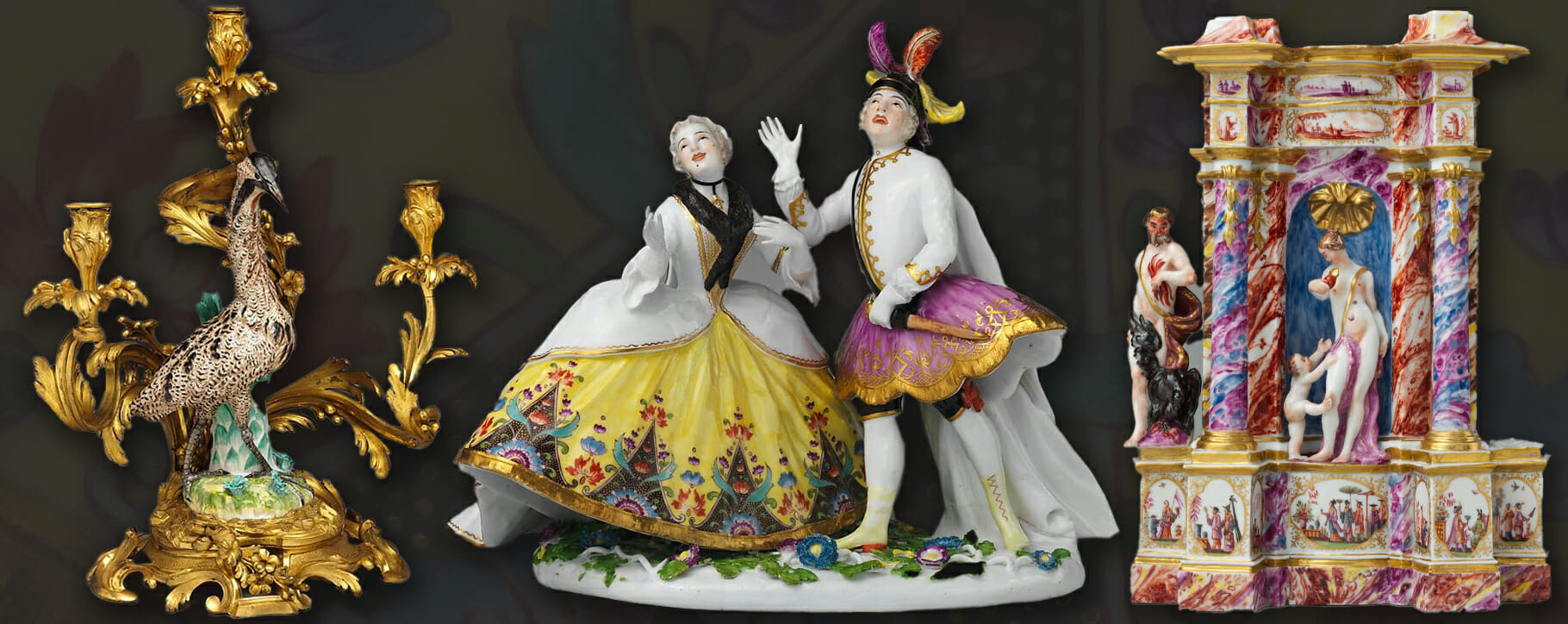 Above: Meissen ornaments may feature under and over glazed painting, as well as gilded areas that can be vulnerable to abrasion
Above: Meissen ornaments may feature under and over glazed painting, as well as gilded areas that can be vulnerable to abrasion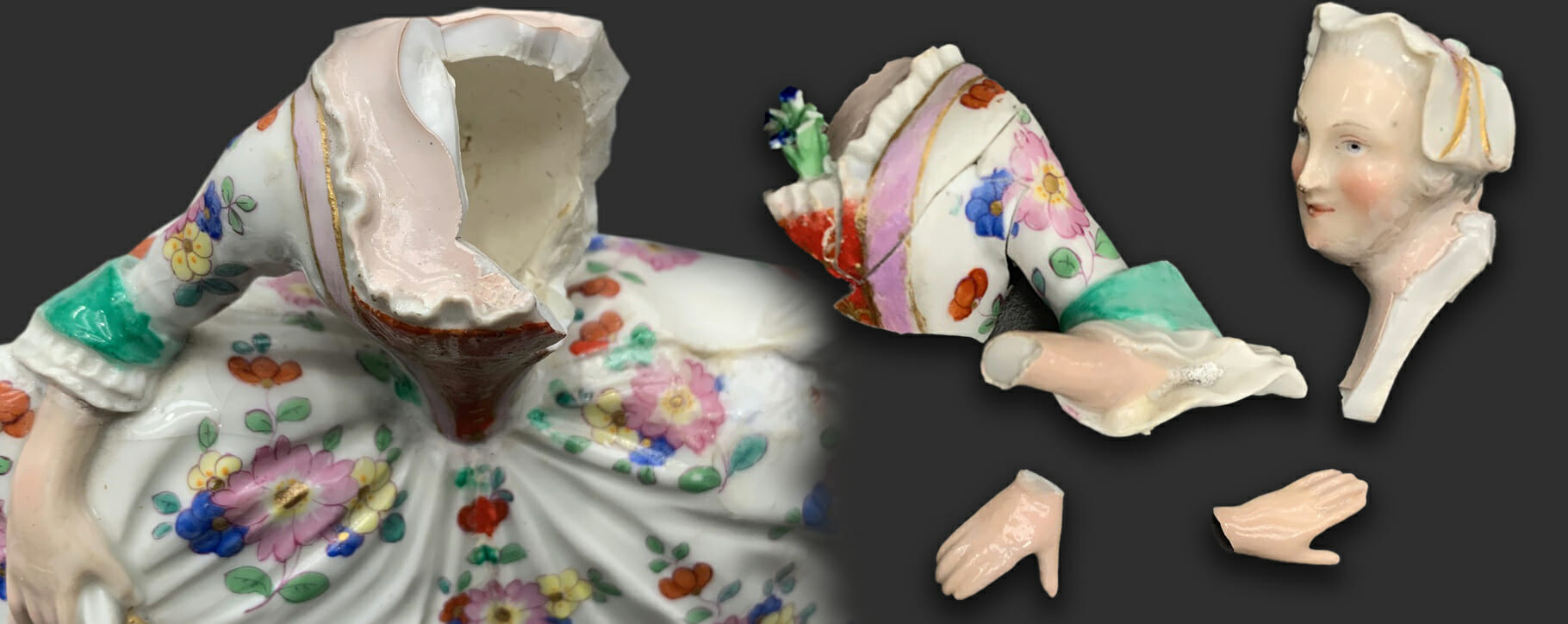 Above: pieces of a broken Meissen figurine before restoration
Above: pieces of a broken Meissen figurine before restoration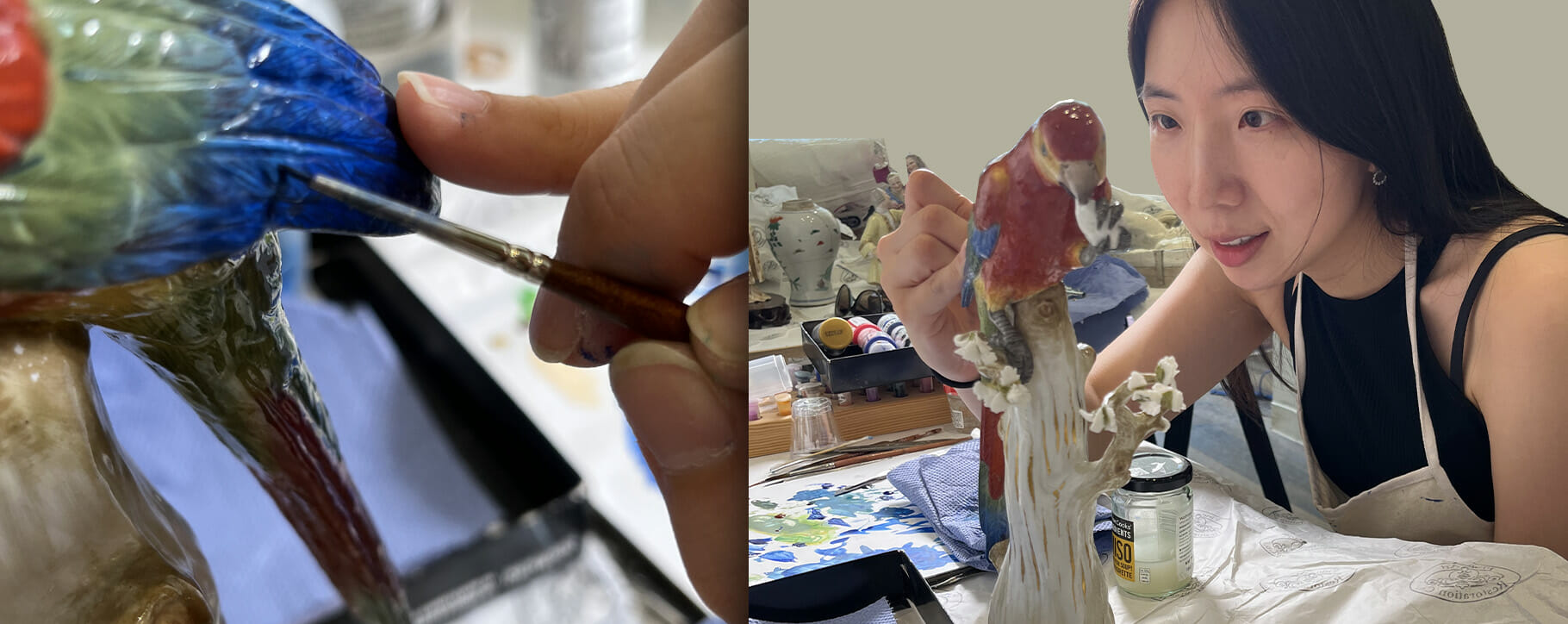 Above: our ceramics conservator restoring small amounts of pigment to a Meissen parrot figurine
Above: our ceramics conservator restoring small amounts of pigment to a Meissen parrot figurine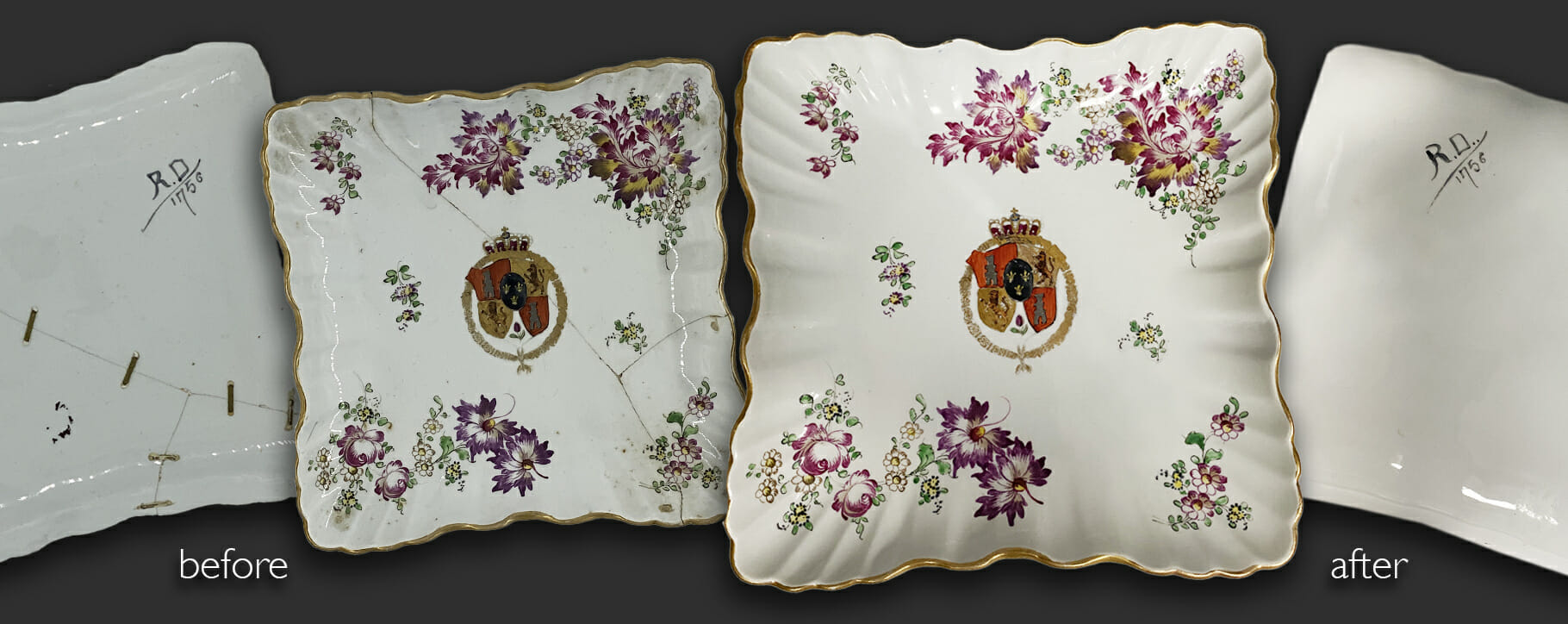 Above: historic repairs such as stapled joins can also be repaired with an invisible finish
Above: historic repairs such as stapled joins can also be repaired with an invisible finish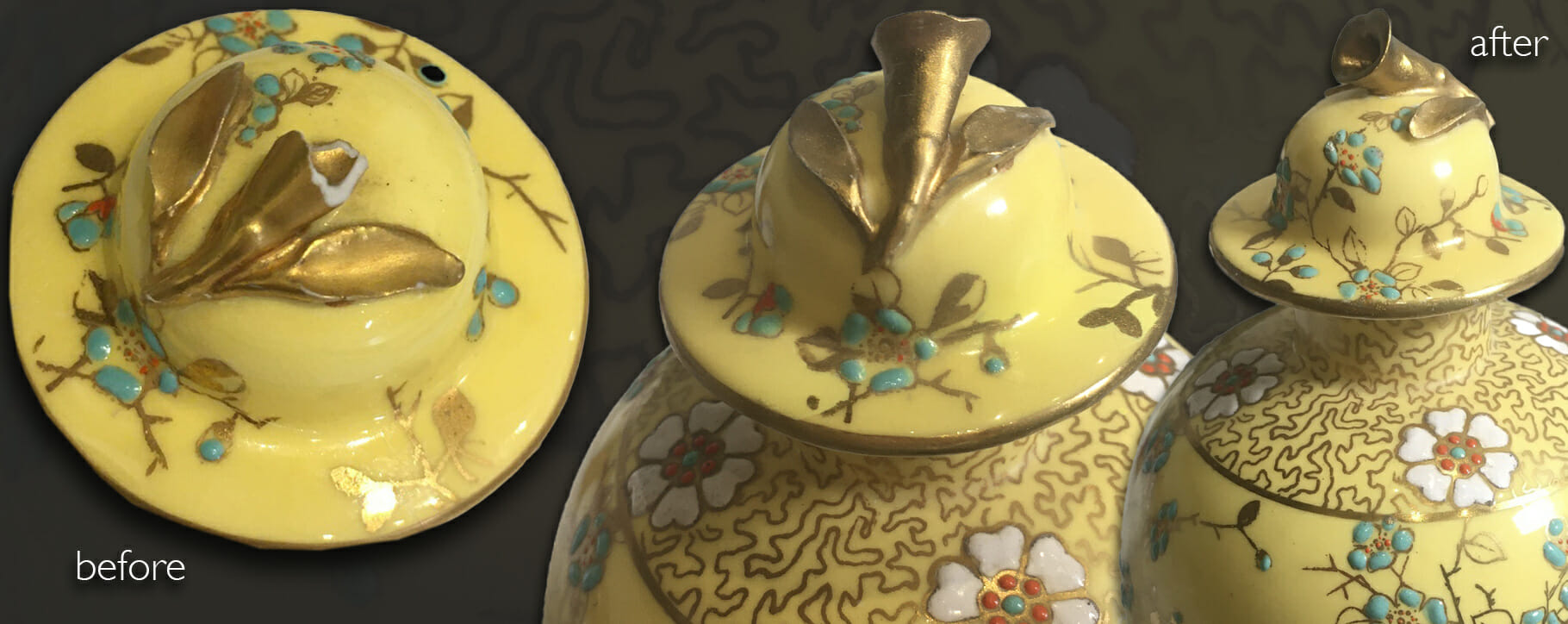 Above: a broken lid on a ginger pot with a sympathetically recreated decoration, carefully colour-matched to the original gilding
Above: a broken lid on a ginger pot with a sympathetically recreated decoration, carefully colour-matched to the original gilding  Above: this vase was shattered after an accidental fall, but fully restored with a seamless result following professional care in our studio
Above: this vase was shattered after an accidental fall, but fully restored with a seamless result following professional care in our studio




